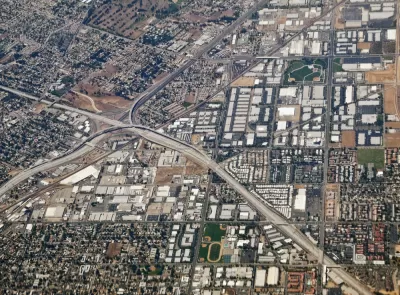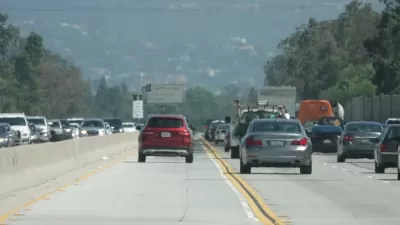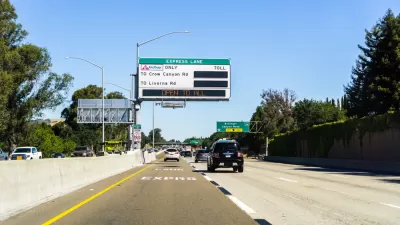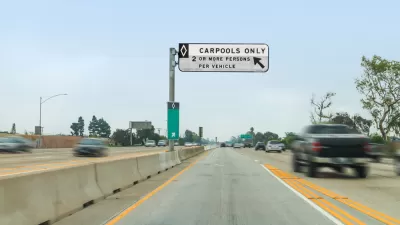No one's suggesting that freeways will be converted to tollways, but a pattern is emerging that when freeways are widened, express lanes, financed in part by user fees, are being added rather than mixed-flow lanes. Case in point: the Inland Empire.

The March opening of the new 91 express lanes in Southern California's Inland Empire is the basis for a broader piece by Imran Ghori, politics reporter for the Press-Enterprise, on future toll lanes coming to the region, a pattern extends beyond California, for two good reasons.
Their growth in the Inland area reflects a regional and national trend in which transportation agencies are turning to toll lanes to finance freeway improvements and manage congestion. The lanes are easier to build because they’re paid for by tolls.
“The idea is catching on quickly and spreading throughout the country,” said Martin Wachs, a professor emeritus of urban planning at the UCLA Luskin School of Public Affairs and an expert on transportation policy and planning.
Congestion management through pricing
[C]harging a toll allows the agencies to manage congestion, while general lanes only provide short-term relief and quickly fill up as they are built, he said. Traffic studies have shown that motorists will readjust their driving patterns and more will drive during peak times when free lanes are added, Wachs said.
“The only way to ensure that traffic is moving more swiftly is to charge people for it,” he said. “It can always reduce congestion because you can raise the price higher and higher until some people choose not to use it.”
Financing through loans paid by user fees
"State and federal transportation dollars are scarcer for projects that don’t do more to manage congestion through carpool or toll lanes," said John Standiford, deputy executive director of the Riverside County Transportation Commission, the agency that built and manages the aforementioned 91 Express Lanes in Riverside County.
I-15 Express Lanes
On July 20, the commission received approval of a critical $152 million Transportation Infrastructure Finance and Innovation Act (TIFIA) loan from the U.S. Department of Transportation for their next project, the 14.6-mile I-15 Express Lanes from the Temescal Valley, south of Corona, north to Jurupa Valley. The $455 million project adds two express lanes in each direction [see fact sheet (pdf)].
"This major award will help offset the local taxpayers’ share of the project cost and means RCTC and its contractor can get to work in 2018 on the I-15 Express Lanes," according to the commission. "The lanes are expected to open in mid-2020."
But this is a loan, not a grant. According to the project's FAQ [pdf]:
How will the toll revenue be used? Toll revenues will be used to operate and maintain the express lanes, repay a portion of the construction costs and pay back the bonds used to finance the project. Any additional revenue will be used for future transportation improvements including freeway, interchanges, and transit enhancements within the I-15 corridor.
Readers may recall that a $629 million TIFIA loan, secured on July 29 by the Orange County Transportation Authority, enabled the San Diego Freeway (I-405) Express Lanes in Orange County to go forward, while sales tax funding will pay for the addition of general purpose lanes.
Why not a public-private partnership?
On the East Coast, Virginia is financing their express lanes differently. Instead of TIFIA loans, they are relying on a public-private partnership to build and operate the 395 Express Lane project. Unlike the Riverside County projects, public transit will be a beneficiary of toll revenues in the agreement negotiated by the Virginia Department of Transportation's Office of Public-Private Partnerships.
San Bernardino County
Finally, Ghori reports on the first toll lanes coming to San Bernardino County – a 33-mile corridor on the 10 Freeway, planned by the San Bernardino County Transportation Authority:
The $1.8-billion project would add two toll lanes from the Los Angeles County line near Montclair east to Redlands. An auxiliary lane for traffic to weave in and out at ramps also will be added at various points along the general-purpose lanes.
Ghori reminds us that while express lanes are effective at reducing congestion and facilitating financing, politically they can be a hard sell.
The decision to use toll lanes has been controversial with some residents and members of the governing board. The board — made up of elected officials from the county and its cities — voted 16 to 2 Wednesday, July 12, to approve an environmental report and to create the toll lanes.
The authority is engaged in two other freeway projects, neither of which involve express lanes, proving that the eral of the "free" freeway will be with us for the foreseeable future.
Hat tip to Steve Birdlebough.
FULL STORY: s Inland toll lanes boom, why are new freeway lanes rarely free?

Depopulation Patterns Get Weird
A recent ranking of “declining” cities heavily features some of the most expensive cities in the country — including New York City and a half-dozen in the San Francisco Bay Area.

California Exodus: Population Drops Below 39 Million
Never mind the 40 million that demographers predicted the Golden State would reach by 2018. The state's population dipped below 39 million to 38.965 million last July, according to Census data released in March, the lowest since 2015.

Chicago to Turn High-Rise Offices into Housing
Four commercial buildings in the Chicago Loop have been approved for redevelopment into housing in a bid to revitalize the city’s downtown post-pandemic.

New Park Opens in the Santa Clarita Valley
The City of Santa Clarita just celebrated the grand opening of its 38th park, the 10.5-acre Skyline Ranch Park.

U.S. Supreme Court: California's Impact Fees May Violate Takings Clause
A California property owner took El Dorado County to state court after paying a traffic impact fee he felt was exorbitant. He lost in trial court, appellate court, and the California Supreme Court denied review. Then the U.S. Supreme Court acted.

How Urban Form Impacts Housing Affordability
The way we design cities affects housing costs differently than you might think.
City of Costa Mesa
Licking County
Barrett Planning Group LLC
HUD's Office of Policy Development and Research
Mpact Transit + Community
HUD's Office of Policy Development and Research
City of Universal City TX
ULI Northwest Arkansas
Town of Zionsville
Urban Design for Planners 1: Software Tools
This six-course series explores essential urban design concepts using open source software and equips planners with the tools they need to participate fully in the urban design process.
Planning for Universal Design
Learn the tools for implementing Universal Design in planning regulations.






















